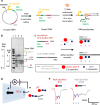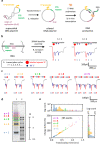Single-molecule RNA sizing enables quantitative analysis of alternative transcription termination
- PMID: 38402271
- PMCID: PMC10894232
- DOI: 10.1038/s41467-024-45968-8
Single-molecule RNA sizing enables quantitative analysis of alternative transcription termination
Abstract
Transcription, a critical process in molecular biology, has found many applications in RNA synthesis, including mRNA vaccines and RNA therapeutics. However, current RNA characterization technologies suffer from amplification and enzymatic biases that lead to loss of native information. Here, we introduce a strategy to quantitatively study both transcription and RNA polymerase behaviour by sizing RNA with RNA nanotechnology and nanopores. To begin, we utilize T7 RNA polymerase to transcribe linear DNA lacking termination sequences. Surprisingly, we discover alternative transcription termination in the origin of replication sequence. Next, we employ circular DNA without transcription terminators to perform rolling circle transcription. This allows us to gain valuable insights into the processivity and transcription behaviour of RNA polymerase at the single-molecule level. Our work demonstrates how RNA nanotechnology and nanopores may be used in tandem for the direct and quantitative analysis of RNA transcripts. This methodology provides a promising pathway for accurate RNA structural mapping by enabling the study of full-length RNA transcripts at the single-molecule level.
© 2024. The Author(s).
Conflict of interest statement
F.B. and U.F.K. are inventors of two patents related to RNA analysis with nanopores (UK patent application no. 2113935.7, in process; UK Patent application nos. 2112088.6 and PCT/GB2022/052171, in process) submitted by Cambridge Enterprise on behalf of the University of Cambridge. U.F.K. is a co-founder of Cambridge Nucleomics. The remaining authors declare no competing interests.
Figures




Similar articles
-
Engineering efficient termination of bacteriophage T7 RNA polymerase transcription.G3 (Bethesda). 2022 May 30;12(6):jkac070. doi: 10.1093/g3journal/jkac070. G3 (Bethesda). 2022. PMID: 35348690 Free PMC article.
-
A novel isothermal method using rolling circle reverse transcription for accurate amplification of small RNA sequences.Biochimie. 2019 Aug;163:137-141. doi: 10.1016/j.biochi.2019.06.003. Epub 2019 Jun 7. Biochimie. 2019. PMID: 31181235
-
Parameters affecting transcription termination by Escherichia coli RNA polymerase. I. Analysis of 13 rho-independent terminators.J Mol Biol. 1992 Mar 5;224(1):31-51. doi: 10.1016/0022-2836(92)90574-4. J Mol Biol. 1992. PMID: 1372365
-
Mechanisms of eukaryotic transcription termination at a glance.J Cell Sci. 2023 Jan 1;136(1):jcs259873. doi: 10.1242/jcs.259873. Epub 2023 Jan 3. J Cell Sci. 2023. PMID: 36594557 Review.
-
Rolling circle amplification: a versatile tool for chemical biology, materials science and medicine.Chem Soc Rev. 2014 May 21;43(10):3324-41. doi: 10.1039/c3cs60439j. Epub 2014 Mar 18. Chem Soc Rev. 2014. PMID: 24643375 Review.
Cited by
-
Single-mode termination of phage transcriptions, disclosing bacterial adaptation for facilitated reinitiations.Nucleic Acids Res. 2024 Aug 27;52(15):9092-9102. doi: 10.1093/nar/gkae620. Nucleic Acids Res. 2024. PMID: 39011892 Free PMC article.
-
Nanopore Translocation Reveals Electrophoretic Force on Noncanonical RNA:DNA Double Helix.ACS Nano. 2024 Jun 11;18(23):15013-15024. doi: 10.1021/acsnano.4c01466. Epub 2024 May 31. ACS Nano. 2024. PMID: 38822455 Free PMC article.
-
mRNA Fragmentation Pattern Detected by SHAPE.Curr Issues Mol Biol. 2024 Sep 16;46(9):10249-10258. doi: 10.3390/cimb46090610. Curr Issues Mol Biol. 2024. PMID: 39329962 Free PMC article.
-
High-throughput sequencing: a breakthrough in molecular diagnosis for precision medicine.Funct Integr Genomics. 2025 Jan 22;25(1):22. doi: 10.1007/s10142-025-01529-w. Funct Integr Genomics. 2025. PMID: 39838192 Review.
-
Programmable RNA Nanostructures Enable Nanopore Detection of Cotranscriptionally Introduced RNA Modifications.Nano Lett. 2025 Aug 13;25(32):12184-12192. doi: 10.1021/acs.nanolett.5c02391. Epub 2025 Aug 4. Nano Lett. 2025. PMID: 40757442 Free PMC article.
References
-
- Sousa, R. & Mukherjee, S. T7 RNA Polymerase. Prog. Nucleic Acid Res. Mol. Biol.73, 1–41 (2003). - PubMed
MeSH terms
Substances
LinkOut - more resources
Full Text Sources

